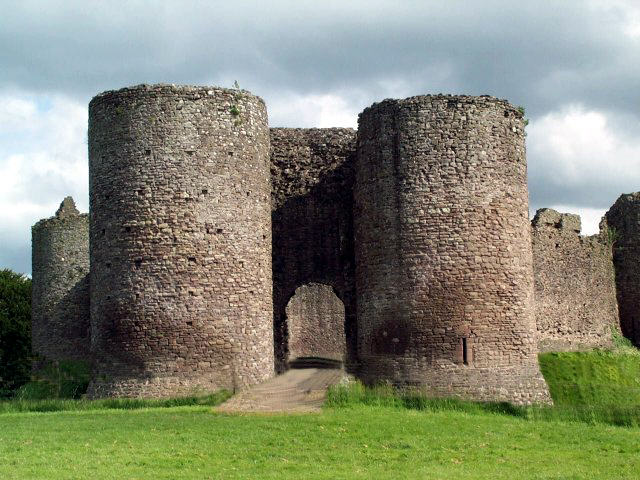
Twin towered gatehouses, like that found at White Castle, Gwent [above], are often thought of as a late thirteenth century constuction and are often assoicated with King Edward I's building campaigns in Wales. However, it is now generally recognised that such features could well predate Edward's time - viz Nottingham, Pevensey and even Harlech. The idea of 2 towers protecting an entrance squeezed between them has an old provenance and can be found in many late Roman forts and even some in the UK, viz. Ambleside (internal rectangular towers), Birdoswald (internal rectangular towers), Brecon (some gently projecting rectangular towers, others internal), Caerhun (internal rectangular towers), Caerleon (rectangular), Cardiff (polygonal towers), Castell Collen (internal rectangular towers), Colchester town wall (projecting D shaped towers), Exeter south gate (internal rectangular towers), Great Chesters (mostly internal rectangular towers), Lincoln (D shaped projecting towers), Lympne (twin solid D turrets?), Manchester?, Melandra (internal rectangular towers), Neath (internal rectangular towers), Newcastle (mostly internal rectangular towers), Pevensey (solid D towers) and Segontium (internal rectangular towers). Obviously, such gatetowers exist throughout the old Roman Empire. Listed below are the main Medieval versions in the West.
Various examples of twin towered gatehouses survive in England at Allington, Alnwick (inner ward), Amberley, Bamburgh, Barnard Castle (outer ward, middle ward), Barnwell, Beeston (inner and outer wards), Berry Pomeroy, Berwick upon Tweed (destroyed), Beverston, Bodiam, Bolingbroke, Brampton Bryan, Bryn Amlwg (destroyed), Bungay, Castle Acre (solid turrets), Chartley, Chester (destroyed), Clifford, Cooling, Corfe, Donnington, Dover (where the towers are rectangular), Dunstanborough, Farnham, Gloucester (destroyed), Goodrich, Hastings, Helmsley, Kenilworth (Mortimer's Tower), Knarlesborough, Lancaster, Launceston (solid turrets), Leybourne, Longtown (solid towers), Mulgrave (solid towers), Pembridge, Pevensey, Pontefract (destroyed), St Briavels, Snodhill (solid turrets to the keep), Nottingham, Rockingham, Rye, St Briavels, Saltwood, Sandwich, Scarborough, Skipton, Southampton (destroyed), Stogursey, Tonbridge, Tower of London, Wallingford (destroyed), Warkworth, Wells, Whittington, Windsor and York (destroyed).
In Wales they exist at Aberystwyth (inner and outer wards), Beaumaris, Buellt (destroyed), Caernarfon, Caerphilly (inner and outer wards and dam), Carmarthen, Carreg Cenen, Chepstow, Criccieth, Crickhowell, Degannwy, Denbigh (main gate has 3 polygonal towers, the town gate 2 rectangular ones), Dinas Bran (with much elongated D towers), Dinefwr (internal rectangular towers, destroyed); Dyserth (destroyed polygonal towers), Harlech, Kidwelly, Laugharne (outer ward, rectangular towers), Llanblethian, Llandaff, Llangibby, Llanstephen, Llawhaden, Montgomery (solid towers), Neath, Newcastle Emlyn (polygonal towers), Newport (polygonal towers), Oystermouth (towers destroyed), Pembroke (outer ward), Pencelli (destroyed), Pennard, Penrice, Picton, Powis, Rhuddlan (inner and outer wards), Swansea outer ward (destroyed), Tinboeth and White Castle.
In Scotland they can be found at Bothwell (unfinished), Caerlaverock, Coull, Kildrummy, Tibbers and Urquhart.
In Ireland they can be found at Ballyadams, Ballylahlan, Ballyloughan, Ballymote, Carlingford (rectangular towers), Carrickfergus, Castle Roche, Drogheda city, Dublin (destroyed), Dunamase (rectangular towers), Dundrum (only 1 tower), Dungarvan, Greencastle (Donegal), Harry Averys, Limerick, Nenagh and Roscommon.
Although there are numerous French examples to be seen they are not as numerous as those in the British Isles, or indeed the Iberian peninsular.
In France they exist in the Cathar region at Carcassonne and Castelnou.
In Gascony, Benauge, Roquetaillade and Villandraut.
In the Ile de France, Ambleny, Beynes, Dourdan, Madeleine, Metz-le-Marechal, Montaiguillon, Montepilloy, Nesles, Saint Clair sur Epte and Yevre le Chatel.
Along the Loire at Ainay-le-Vieil, Angers, Auneau, Bommiers, Champtoce, Chateau-Renault, Guerande, Lavardin, Le Grand Pressigny, Les Essarts, Loches city, Montreuil-Bellay, Nogent le Rotou, Oudon, Pouance, Ranrouet and Vaujours.
In Lot at Najac.
In the Nord they exist at Ambleny (solid turrets), Boulogne, Cambrai city, Chacenay, Coucy, Montreuil-sur-Mer, Picquigny, Royere and Sedan.
In Normandy remains exist at Alencon, Arques, Bellencombre, Caen, Courcy, Domfront, Falaise, Fresnay-sur-Sarthe, Harcourt, Ivry, Lassay, Longueville (solid towers), St Saveur Le Vicomte, Tancarville and Valmont.
In Poitou-Charentes at Crocq, Gencay, La Rochefoucauld, Niort, Parthenay and Sanzay.
In Provence at Chateaurenard, Villard and Villeneuve-les-Avignon.
In the Low Countries a few examples exist at Chateau des Comtes de Salm (lop-sided), Corroy-le-Chateau, La Royere and Tarcienne.
There are few examples in eastern Europe. In Germany there are 2 in Hesse at Monschau and Reifferscheid (solid), while another 3 exist in the Rhine-Palatinate at Bertradaburg, Kasselburg and Welschbillig.
The rest of these structures appear to be found only in the West of Europe with a few examples in Italy at Naples, Nicastro, Oliveto (a hole in the wall gate between 2 rectangular towers), Orsini (near Ornaro), Prato (a hole in the wall gate between 2 rectangular towers), Rocca Imperiale (2 rectangular buttresses), Stilo (lopsided) and Castello a Mare (octagonal towers) in Sicily.
Twin towered gatehouses abound in the Iberian Peninsula, although they tend towards rectangular rather than D shaped towers as in Britain and France. In Spain they are found at Avila, Banos de la Encina (square), Carrion de Calatrava la Vieja (rectangular), Castro de San Cibrao (prehistoric, D), Chinchilla de Montearagon, Coria (1 round, 1 square; Roman walls (2 rectangular), Jadraque (1 round, 1 square), La Alhambra (square, solid), Loarre, Lugo (Roman), Monleon, Morella city (rectangular), Pelegrina (solid), Penafiel, Penaranda de Duero, Ponferrada, Sadaba (square), Sax (solid, lopsided), Segovia city (1 polygonal, 1 square), Siguenza (solid), Tabernas (square, hole in wall between), Tarifa (square), Toledo city (D & square, x2rectangular, x2round), Trujillo and Ucero.
In Portugal twin towered gatehouses appear at Alandroal, Alcacer do Sal (solid? Rectangular with hole inbetween), Arraiolos (solid? Rectangular with hole inbetween), Braganca (solid rectangular), Carrazeda de Ansiaes (solid rectangular), Castelo Mendo (rectangular), Guimaraes (solid rectangular), Idanha-a-Velha, Lanhoso (solid rectangular), Lousa (solid), Miranda do Douro (solid? Rectangular with hole inbetween), Mourao (Solid? Rectangular), Nisa (Solid? Rectangular), Penedono (rectangular towers), Redondo (solid), Serpa , Sesimbra (solid, rectangular), Veiros (solid) and Vila Vicosa (solid).
If you know of any castles or indeed any Roman structures to add to this list please email Paul.